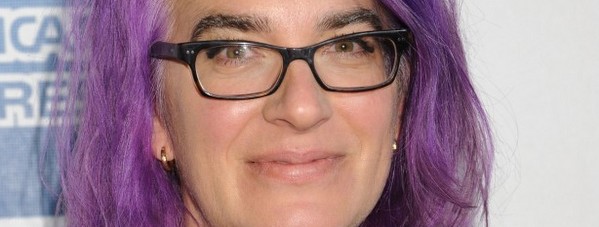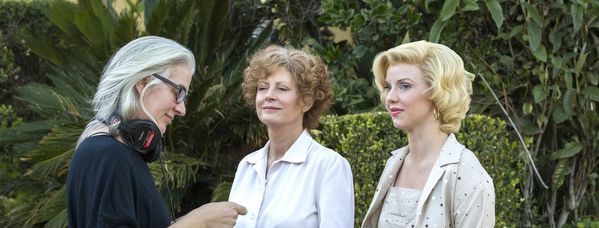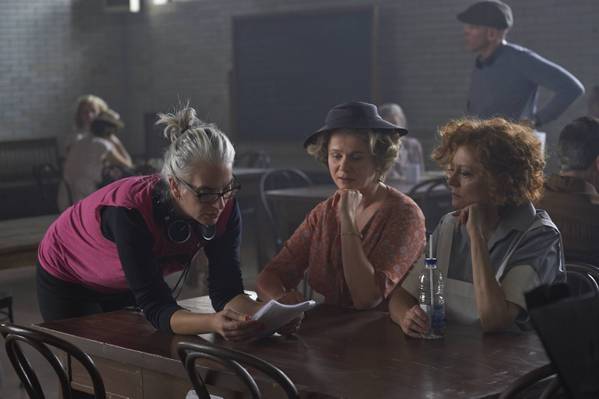I directed a miniseries for Lifetime called The Secret Life of Marilyn Monroe. It is my biggest job to date.

I was a child of the 70’s who came of age in the 90’s and I’m still dealing with fallout from all of that. When I was 19 years old I spent a summer slumming with anarchists at the Greenham Common Women’s Peace Camp in England. It was then and there that I realized I didn’t really have it in me to be an activist. But I did write a film short which I directed a couple of years later. “Invited to Dinner” is 2 ½ minutes long and shows a happy housewife setting the dinner table. Next thing you know she’s naked, climbing into the serving dish. It is a perfect example of “bad feminist art”. But I love it anyway. I grew up in a middle class suburb in NJ. Pretty boring. I’m trying to give my kids a more fun childhood than I had. We live in Brooklyn.
Check out @lauriecollyer ‘s #SunlightJr starring @wwwbigbaldhead Heres a clip of #NaomiWatts #NormanReedus & me @hulu pic.twitter.com/sSN9y0vp59
— Fernando Martinez (@itsthenando) October 8, 2015
How would you describe your work as a director
I am a collaborator and extremely social. I love to be around people and always go into withdrawal at the end of a shoot. I believe in research and prep, prep, prep. I have been described as “nurturing” “diligent” and “passionate”. I am most interested in making the actors feel free. I worship my DP because they do things I could not possibly ever do. I love to use the edges of my frame and I love when the lighting and production design support the narrative, rather than exist on their own as aesthetic elements. My work is rooted more in reality than in cinema. I would much rather create a look-book from documentary photographs than from movie stills. I am interested in picking up a rock and watching the bugs squirm in the light. Or shining a flashlight under the bed. And I particularly adore complicated, misunderstood protagonists. Losers who get to win. Love is also an important story for me to tell. It’s never enough. And at the same time, it’s always worth fighting for.
How did you get into directing
I never really planned to be a director. I had a boyfriend who told me to take art classes because I was “obviously some kind of artist” so I listened to him and took a couple of photography and Super 8 filmmaking classes at the local city college. My job at the time was working with Special Ed kids, one of whom was a severely disabled teenager named Thanh. In class, I got an assignment to make a film about a chair. Thanh had this super tricked out wheelchair with a Touch Talker attached (a la Stephen Hawking). I made a silent Super 8 film about Thanh and her chair and everyone in the class told me to make a longer documentary about her. I did and wound up screening a 10 minute cut of it at Neil Young’s Bridge School Benefit Concert. It was then that I decided to become a filmmaker. Watching my film with an audience of 22,000 made me realize how powerful the medium could be. I wanted to be part of that.
How do you choose a project to direct
I think that in some ways my projects choose me. Lately, I’m looking for challenges. I want to do things I haven’t done before. I want to direct a comedy. I want to direct action. Genre films. But it always comes down to the story. Is it a story I understand and feel deeply? Is there something I need to learn from this story? If so, then it’s for me.
What uniqueness can female directors bring to film, TV and cinema
That’s a hard question. We’re all different. We may even be more different from each other than men are from women. But one thing we share is that we were born and raised women in a patriarchal society. So we have all experienced some form of oppression. I don’t know if that lends our films a “uniqueness” but it may make us good at adapting in difficult situations. The problem is we’re not always allowed to show our emotion. And like any creative act, directing is super emotional. I’ve heard stories of male directors screaming at their crews. I’m not sure a woman would get away with that behavior. Not on the regular. I would never advocate treating crew like crap, that’s not what I’m saying. I’m saying that I think the rules are different. I think we’re not allowed to have warts and bumps in the way that male directors are. I also think we have to be twice as good to be considered for a job. But I don’t think that affects the way we tell stories. The job is the job and there are as many styles of director as there are directors. It’s important to remember that we are not curing cancer. The work sometimes feels more important than it is. We are spending lots of other people’s’ money. It’s a big responsibility. I’m not sure that gender has anything to do with how we take on this responsibility. Gender plays a role much more in the opportunities we are given to pitch and then win the job. Women get to do that much less frequently.
Do you take courses to increase your craft
I want to! But I haven’t taken any courses since the Sundance Labs of 2002
What books do you read
Right now I am reading The Husband’s Secret by Liane Moriaty, From Selma to Sorrow by Mary Stanton, and The Practice of the Wild by Gary Snyder. I recently finished Discount by Casey Gray, The Drummond Girls by Mardi Jo Link and The Shock of the Fall by Nathan Filer. I also read a ton of scripts. And articles
Why will you choose an actor, writer or producer. What do you look for
I look at track record, past work. I look for similar sensibilities. I look for an ability to communicate with one another. I look for passion for the project. Directing is an intimate job so you have to partner with people you feel comfortable with on a deep level. I use my instinct a lot, as well as word of mouth.
When you are offered a project, what things do you put in place to deliver a good job
I do as much research on the subject as I can. I am a research fiend. I make sure that we (director, actors, producers, art dept, DP) are all making the same film. I ask for excellence from all of my crew. I shy away from work I can’t summon passion for. The film business, like any business, tends to be risk averse. Directors love to take risks. That can cause conflict. I try to let everyone I work with know that I only want what’s best for the movie. It’s not personal if I don’t like your take or your idea. But it won’t work if we’re not all making the same movie. Fortunately, I have never been in that situation.
Briefly explain your latest work
I directed a miniseries for Lifetime called The Secret Life of Marilyn Monroe starring Kelli Garner, Susan Sarandon, Emily Watson and Jeffrey Dean Morgan. It was my biggest job to date. I hope to get more TV work, because as with my first experience screening at Neil Young’s concert, this time I experienced the power of the TV audience. 2.2 million people watched the miniseries.
Explain key challenges on your last film
My challenges were all connected to the short schedule. 220 pages in 42 days. 5 weeks of prep. Getting all the fittings in alone — we cast our MM late in the schedule and my actress had 95 costume changes, 7 wigs and very elaborate makeup for each time period and age she was representing.
On set we had two hours for each wig change and 1-3 hours for each makeup change. The script made it difficult to stay with one look for too long because it was a cradle-to-grave biopic. Kelli was in almost all of the scenes. That also shortens the day because of her turnaround. Some days we only had 6 shooting hours.
I did full page turns of the script with the hair and makeup departments during prep which I’d never done before. It was kind of like a doing a special effects hair and makeup show, because Norma Jean/Marilyn’s look and transformation had to be so elaborate. She was Hollywood’s biggest movie star. Her makeup design is a story in itself. Whitey Snyder used five different shades of red to get that trademark MM red. Our makeup artist, Jordan Samuel, did too. You can see the transformation happen on screen in the scene where Marilyn first meets Whitey. I love that moment. The real Marilyn had a nose job, so we decided to use makeup to represent a shift in her face. Adding shadow to her nose to change the shape of it. Then you have Marilyn’s hair. Over the years she was taken from thick, dark and curly to soft, straight and blonde. Like I said we had 7 wigs. There were stages Marilyn went through before becoming the bombshell. We wanted to get all that. From the long honey blonde to the short honey blonde all the way up to Pearl (our hair stylist Cliona Furey’s nickname for the white blonde JFK wig). Both hair and makeup were nominated for the Emmy for their work in the show.
Costume designer Gersha Phillips and I made a concerted effort to recreate most of MM’s actual wardrobe. The dresses we had built included her Norma Jean country dress, the white overall romper with red striped tee shirt, the JFK Happy Birthday dress, the Arthur Miller sundress, the Joe DiMaggio white halter dress, the Photoplay gold lamé dress, the Seven Year Itch dress, the All About Eve total ensemble (including foxes). Many, many others. The checkered trousers. The orange Pucci sweater. The bow dress. The black blazer with mink lapels. We wanted a deep level of historical accuracy in our visual story which included a very specific, true-to-what-she-wore wardrobe.
There were a few days we had 3 wig changes and were not allowed to do any overtime. Covering scenes when you only have 6 shooting hours is like sprinting to the finish line. But we figured out how to do it simply and economically. Two cameras kept it elegant. Three cameras would have made it looks worse. I understand the idea of cross coverage but I’m glad we didn’t do any in this show. The compositions are more interesting.
In the VFX scenes or big crowd scenes we had much more complicated camera moves and lighting design. I remember there was some controversy about staging shots that took time to set when we had just a few hours left in our day. But Chris Manley and I made up our minds early in the show that we would preserve elaborate camera moves at all costs. Manley is also nominated for an Emmy for his work on the show. I am proud of all my cast and crew!
What thing or situation helps you during a production
No conflict, everyone doing their jobs, being on schedule. That all helps a ton!
Explain a creative choice you made during a production
Reduce amount of coverage to give the actors as much time as they needed to get the performance. With a schedule like ours, something had to give. So I decided that instead of cover scenes from a million different angles, we’d limit the amount of setups to give the actors more takes within setups.
How do you advise female directors to find projects
I give advice to all kinds of filmmakers and I always say the same thing – follow your muse! I don’t really want to separate us into two categories of “women directors” and “directors”. A director is a director. It’s just that some of us get more opportunities than others. I have no advice on that subject that I wouldn’t give all filmmakers – grab every opportunity and never stop making your own.
How can filmmakers finance their projects
Good producers!
What do you want from an actor during production
I want commitment to the role. I want them to care as much as I do. I can’t ask for more or less or I wouldn’t be doing my job. I also want them to be comfortable in their discomfort, by that I mean, I want them to take risks, to really go for it and not worry that they’ll look stupid. But the material has to be good enough to warrant that level of expectation. So I have to also do my job and make the material shine, make the look of the film, the mise-en-scene, as good as it can be.
How do you prefer to work with a producer during a production
As I mention above, I like to collaborate. But the one thing I ask my producers is not to give my actors or my DP direction. They can freely give me the note and I will transmit. I also ask them not to give me notes about performance right after a take. It’s really hard to come up with a good note for an actor after a take. There is such a short amount of time where you have to communicate so much. So I really need to focus. If I’m ready to move on and the producer is concerned I welcome the opportunity to go again. So I check in and make sure they’re happy. I just think that boundaries are important and actors’ performances are what make or break a film. They shouldn’t get direction from more than one person and they shouldn’t have to deal with a muddled or confused director. The amount of concentration you need to make sure you have the performance is intense. I used to stand near the camera more but on my last job with a 2 camera shoot in tight locations, it was difficult. I think next time I have to be more physically near the actors and I won’t have to concentrate so hard because I will just feel it. Directing is all about harnessing emotion. Knowing what to say to your actor comes from feeling what they are doing. I like a producer who is a partner.
What can a female director do to get into the film industry
Same thing as a male director, work their asses off!
Who is your favorite director
I always come back to John Cassavetes and Rainer Werner Fassbinder. PT Anderson too. All three of these guys take enormous risks. They’re not afraid to fail and so when they succeed, they succeed enormously. I also love Jill Soloway. Transparent is a revelation. I can’t get enough of it. Some of my favorite films are documentaries. I loved What Happened Miss Simone? by Liz Garbus, The Wolfpack by Crystal Moselle. Gray Gardens and Streetwise are two of my all time favorites. I also really love Gus Van Sant. Drugstore Cowboy, Paranoid Park, Elephant, Last Days, I love all those movies. I have a particular weakness for 70’s Hollywood movies.
Why
I love the worlds these directors create, the emotions they evoke and of course, the stories they tell. Stories of outsiders. Unconventional love stories. Families falling apart and coming together in new ways. Families we choose as opposed to families we’re born into. Monsters that live inside us, what happens when they come out? I also love all the actors in these movies. Gena Rowlands, Peter Falk, Brigitte Mira, El Hedi ben Salem, Hanna Schygulla, Ingrid Caven, Michael Pitt, Matt Dillon, Kelly Lynch, James Legros, Heather Graham, John Robinson, Tim Bottoms, Jeffrey Tambor, Gaby Hoffman, Amy Landecker, Tig Notaro. And all the rest of them, they are all delicious, wonderful actors.
What advice will you give female directors around the world
There is no difference between a female director and a male director.
Briefly write about your career
My filmography is as follows:
- Nuyorican Dream, 2000, feature documentary about three generations of a New York Puerto Rican family who have been cast aside from the American Dream. Premiered at Sundance 2000. Broadcast on HBO/Cinemax.
- Sherrybaby, 2006, is the story of a woman recently released from prison and the trials and tribulations she faces trying to stay sober and parent her child. Starring Maggie Gyllenhaal, Danny Trejo, Giancarlo Esposito, Sam Bottoms, Ryan Simpkins, and Brad William Henke. Premiered at Sundance 2006. Won major prizes at Karlovy Vary Film Festival, Deauville Film Festival. Maggie was also nominated for a Golden Globe for her performance.
- Sunlight Jr., 2013, is a bittersweet love story set in a world of working class poverty. Stars Naomi Watts, Matt Dillon, Norman Reedus and Tess Harper. Premiered at Tribeca Film Festival 2013.
- The Secret Life of Marilyn Monroe, 2015, a biography of the late movie star that features her relationship with her paranoid schizophrenic mother. Starring Kelli Garner, Susan Sarandon, Emily Watson and Jeffrey Dean
Morgan. Nominated for 3 Emmy Awards – Hair, Makeup and Cinematography.
INTERVIEWS
more interviews











